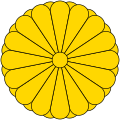
Back Cort del Nord Catalan Severní dvůr Czech Corte del Norte Spanish Iparraldeko Gortea (Japonia) Basque دربار شمالی Persian Cour du Nord French Pemerintahan Utara (Jepang) ID Corte del Nord Italian 北朝 (日本) Japanese 북조 (일본) Korean
Northern Court 北朝 Hokuchō | |||||||||||
|---|---|---|---|---|---|---|---|---|---|---|---|
| 1331/1336–1392 | |||||||||||
| Capital | Heian-kyō | ||||||||||
| Common languages | Late Middle Japanese | ||||||||||
| Religion | Shinbutsu shūgō | ||||||||||
| Government | Monarchy | ||||||||||
| Emperor | |||||||||||
• 1331–1333 | Kōgon | ||||||||||
• 1336–1348 | Kōmyō | ||||||||||
• 1348–1351 | Sukō | ||||||||||
• 1352–1371 | Go-Kōgon | ||||||||||
• 1371–1382 | Go-En'yū | ||||||||||
• 1382–1392/1412 | Go-Komatsu | ||||||||||
| History | |||||||||||
• Established | 1331/1336 | ||||||||||
• Re-unification of Imperial courts | August 11 1392 | ||||||||||
| |||||||||||
The Northern Court (北朝, hokuchō), also known as the Ashikaga Pretenders or Northern Pretenders, were a set of six pretenders to the throne of Japan during the Nanboku-chō period from 1336 through 1392.[1] Even though the present Imperial House of Japan is descended from the Northern Court emperors, The Southern Court is considered the legitimate line, with the argument being that it was the Southern court which possessed the Imperial Regalia, which was later handed over to the Northern court, thus making Emperor Go-Komatsu the 100th Emperor of Japan. It was in 1911 that Emperor Meiji passed an edict which made the Southern line the legitimate one. [2] Earlier, it was thought by pre Meiji scholars that It was the Northern line which was the legitimate line.
The Northern dynasty is also referred to as the "senior line" or the Jimyōin line (持明院統, Jimyōin-tō); Jimyō-in was a temple and retirement residence of this line's emperors Go-Fukakusa and Fushimi.[3]
- ^ Nussbaum, Louis Frédéric and Käthe Roth. (2005). Japan Encyclopedia, p. 251; n.b., Louis-Frédéric is the pseudonym of Louis-Frédéric Nussbaum, see Deutsche Nationalbibliothek Authority File Archived 2012-05-24 at archive.today.
- ^ Cite error: The named reference
concisewas invoked but never defined (see the help page). - ^ Kanai, Madoka; Nitta, Hideharu; Yamagiwa, Joseph Koshimi (1966). A Topical History of Japan. UM Libraries. p. 42. UOM:39015005373116.
© MMXXIII Rich X Search. We shall prevail. All rights reserved. Rich X Search
